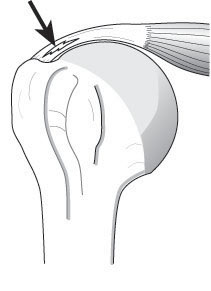In partial thickness cuff tears loss of some of the tendon fibers reduces the ability of the attached muscle fibers to deliver force to the bone. This disruption typically starts on the deep surface of the cuff.
, but may also occur within the tendon
or on the bursal side.
Partial tears may be accompanied by avulsion of a piece of the greater tuberosity
A thinned tendon contains fewer fibers than one of normal thickness; thus, a muscle with a thinned tendon has lost the optimal attachment of its contractile elements and increasing load is placed on the remaining fibers
Partial tendon tears can also prevent effective use of the muscle by producing pain on muscle contraction. In this respect a partial thickness cuff tear resembles a tennis elbow, a condition in which the extensor carpi radialis brevis is partially torn from the latter epicondyle. Contraction of the muscle produces pain at the tendon attachment to bone. This condition is also similar to partial thickness tears at the insertion of the Achilles and patellar tendons. While these conditions are often thought to be inflammatory (“tendonitis”), the problem is actually mechanical.
This progressive tendon tearing is often progressive, each step in the progression may be interpreted as episodes of ‘tendonitis’ until it is recognized that the problem is a cuff tear.
--
How you can support research in shoulder surgery Click on this link.Here are some videos that are of shoulder interestShoulder arthritis - what you need to know (see this link).How to x-ray the shoulder (see this link).The ream and run procedure (see this link).The total shoulder arthroplasty (see this link).The cuff tear arthropathy arthroplasty (see this link).The reverse total shoulder arthroplasty (see this link).The smooth and move procedure for irreparable rotator cuff tears (see this link).Shoulder rehabilitation exercises (see this link).
--
How you can support research in shoulder surgery Click on this link.
Here are some videos that are of shoulder interest
Shoulder arthritis - what you need to know (see this link).
How to x-ray the shoulder (see this link).
The ream and run procedure (see this link).
The total shoulder arthroplasty (see this link).
The cuff tear arthropathy arthroplasty (see this link).
The reverse total shoulder arthroplasty (see this link).
The smooth and move procedure for irreparable rotator cuff tears (see this link).
Shoulder rehabilitation exercises (see this link).







